Microstructural, Mechanical, and Corrosion Properties of AZXX Magnesium Alloy: A Review of Processing Methods
Abstract
:1. Introduction
2. Processing of AZXX Mg Alloy
| S. No. | Material | Process | Solutionizing—Temp. (C); Time (Hours); Quenching Medium | T6 Temp. (C); Time (Hours) | Hardness (HV) | YS (MPa) | UTS (MPa) | Ductility (%) | Ref. |
|---|---|---|---|---|---|---|---|---|---|
| 1 | AZ80 | Casting | - | - | - | 100 | 190 | 6 | [25] |
| 420; 4; water | - | 110 | 270 | 17 | |||||
| 420; 8; water | - | 100 | 260 | 18 | |||||
| 420; 10; water | - | 90 | 265 | 16 | |||||
| 420; 16; water | - | 85 | 270 | 15 | |||||
| 420; 4; water | 200; 10 | - | 150 | 280 | 7 | ||||
| 420; 8; water | 200; 10 | - | 140 | 260 | 12 | ||||
| 420; 10; water | 200; 10 | - | 150 | 290 | 9 | ||||
| 420; 16; water | 200; 10 | - | 130 | 280 | 7 | ||||
| 2 | AZ80 | Extrusion | - | - | 69.1 | 201 | 312 | 10.1 | [26] |
| 400; 10; water | 66.6 | 185 | 305 | 10.3 | |||||
| 400; 10; water | 200 | 92 | 227 | 334 | 4 | ||||
| 4 | AZ80 | Casting | - | - | 61.4 | - | - | - | [27] |
| 360; 1; water | 170; 2 | 62.5 | - | - | - | ||||
| 360; 1; water | 170; 4 | 61.7 | - | - | - | ||||
| 360; 1; water | 170; 6 | 60.8 | - | - | - | ||||
| 360; 1; water | 170; 8 | 53 | - | - | - | ||||
| 5 | AZ80 | Casting | - | - | 61.2 | - | - | - | [28] |
| 420; 10; water | 64 | - | - | - | |||||
| 420; 10; water | 200; 10 | 83.5 | - | - | - | ||||
| 380; 10; air cooling + 420 C; 10; water | - | 63.7 | - | - | - | ||||
| 380; 10; air cooling + 420 C; 10; water | 200; 10 | 86 | - | - | - | ||||
| 6 | AZ80 | casting | - | - | 68 | - | - | - | [29] |
| 250; 6 | - | 69 | - | - | - | ||||
| 250; 12 | - | 73 | - | - | - | ||||
| 350; 6 | - | 67.5 | - | - | - | ||||
| 350; 12 | - | 70 | - | - | - | ||||
| 450; 6 | - | 66 | - | - | - | ||||
| 450; 12 | - | 66 | - | - | - | ||||
| 7 | AZ80 | wire arc additive manufacturing | - | - | - | 146 | 308.7 | [23] | |
| 8 | AZ80 | Multitemperature Multidirectional Forging + Extrusion | 400; 24 | - | - | 292 | 420 | - | [30] |
| 9 | AZ80 | Casting | - | 73.1–84.4 | 138–153.7 | - | [31] | ||
| 10 | AZ80 | Horizontal Flat Die Extrusion | 64–72 | 287 | 162 | - | [32] | ||
| AZ80 | Thixocasting | - | - | - | 102 | 187 | 3.5 | [16] | |
| 400; 24; water | - | - | 92 | 224 | 7.7 | ||||
| AZ91 | Squeeze casting | - | - | - | 104 | 183 | 4.5 | ||
| Rheocasting | - | - | - | 105 | 171 | 3.4 | |||
| 400; 24; water | - | - | 94 | 241 | 8.3 | ||||
| AZ71 | - | - | - | 98 | 185 | 4.7 | |||
| 400; 24; water | - | - | 88 | 262 | 11.2 | ||||
| 11 | AZ21 | Gravity Die Casting | 53.9 ± 2.1 | 89 | 113 | 3.4 | [33] | ||
| 12 | AZ31 | Hot rolled | 147 | - | 260 | 22.5 | [34] | ||
| AZ61 | Hot rolled | - | - | 260 | 22.5 | [34] | |||
| 13 | AZ31 | Extrusion | - | 191.8 | 268.1 | 23.9 | [35] | ||
| 14 | AZ31 | Extrusion | 450; 3; water | - | 162 | - | - | [36] | |
| AZ61 | 420; 6; water | - | 55.4 | 198 | - | - | |||
| AZ91 | 400; 10; water | - | 62.7 | 227 | - | - | |||
| AZ91 | 400; 10; water | 210; 15 | 81.6 | 271 | - | - | |||
| 15 | AZ91D | HPDC | 188 | 255 | 3.0 | [37] | |||
| 16 | AZ91 | HPDC | 150 | 240 | 3.0 | [38] |
3. Microstructural Analysis
4. Mechanical Properties
5. Corrosion Behaviour
6. Summary and Outlook
Author Contributions
Funding
Institutional Review Board Statement
Informed Consent Statement
Conflicts of Interest
References
- Motallebi, R.; Savaedi, Z.; Mirzadeh, H. Post-processing heat treatment of lightweight magnesium alloys fabricated by additive manufacturing: A review. J. Mater. Res. Technol. 2022, 20, 1873–1892. [Google Scholar] [CrossRef]
- Sun, J.; Du, W.; Fu, J.; Liu, K.; Li, S.; Wang, Z.; Liang, H. A review on magnesium alloys for application of degradable fracturing tools. J. Magnes. Alloy 2022, 10, 2649–2672. [Google Scholar] [CrossRef]
- Jayasathyakawin, S.; Ravichandran, M.; Baskar, N.; Chairman, C.A.; Balasundaram, R. Mechanical properties and applications of Magnesium alloy—Review. Mater. Today Proc. 2020, 27, 909–913. [Google Scholar] [CrossRef]
- Hussein, R.O.; Northwood, D.O. Improving the performance of magnesium alloys for automotive applications. WIT Trans. Built Environ. 2014, 137, 531–544. [Google Scholar] [CrossRef] [Green Version]
- Ali, M.; Hussein, M.; Al-Aqeeli, N. Magnesium-based composites and alloys for medical applications: A review of mechanical and corrosion properties. J. Alloys Compd. 2019, 792, 1162–1190. [Google Scholar] [CrossRef]
- Zhang, T.; Wang, W.; Liu, J.; Wang, L.; Tang, Y.; Wang, K. A review on magnesium alloys for biomedical applications. Front. Bioeng. Biotechnol. 2022, 10, 953344. [Google Scholar] [CrossRef]
- Poinern, G.E.J.; Brundavanam, S.; Fawcett, D. Biomedical Magnesium Alloys: A Review of Material Properties, Surface Modifications and Potential as a Biodegradable Orthopaedic Implant. Am. J. Biomed. Eng. 2012, 2, 218–240. [Google Scholar] [CrossRef] [Green Version]
- Yartys, V.; Lototskyy, M.; Akiba, E.; Albert, R.; Antonov, V.; Ares, J.; Baricco, M.; Bourgeois, N.; Buckley, C.; von Colbe, J.B.; et al. Magnesium based materials for hydrogen based energy storage: Past, present and future. Int. J. Hydrogen Energy 2019, 44, 7809–7859. [Google Scholar] [CrossRef]
- Baran, A.; Polański, M. Magnesium-Based Materials for Hydrogen Storage—A Scope Review. Materials 2020, 13, 3993. [Google Scholar] [CrossRef]
- Yaroshevsky, A.A. Abundances of chemical elements in the Earth’s crust. Geochem. Int. 2006, 44, 48–55. [Google Scholar] [CrossRef]
- Tong, F.; Wei, S.; Chen, X.; Gao, W. Magnesium alloys as anodes for neutral aqueous magnesium-air batteries. J. Magnes. Alloy 2021, 9, 1861–1883. [Google Scholar] [CrossRef]
- Papenberg, N.P.; Gneiger, S.; Weißensteiner, I.; Uggowitzer, P.J.; Pogatscher, S. Mg-Alloys for Forging Applications—A Review. Materials 2020, 13, 985. [Google Scholar] [CrossRef] [PubMed] [Green Version]
- Liu, H.; Cao, F.; Song, G.-L.; Zheng, D.; Shi, Z.; Dargusch, M.S.; Atrens, A. Review of the atmospheric corrosion of magnesium alloys. J. Mater. Sci. Technol. 2019, 35, 2003–2016. [Google Scholar] [CrossRef]
- Tan, J.; Ramakrishna, S. Applications of Magnesium and Its Alloys: A Review. Appl. Sci. 2021, 11, 6861. [Google Scholar] [CrossRef]
- Zhang, N.X.; Kawasaki, M.; Ding, H.; Langdon, T.G. An examination of microstructural evolution and homogeneity in a magnesium AZ80 alloy processed by high-pressure torsion. Mater. Sci. Eng. A 2021, 806, 140832. [Google Scholar] [CrossRef]
- Kleiner, S.; Beffort, O.; Wahlen, A.; Uggowitzer, P. Microstructure and mechanical properties of squeeze cast and semi-solid cast Mg–Al alloys. J. Light Met. 2002, 2, 277–280. [Google Scholar] [CrossRef]
- Rakshith, M.; Seenuvasaperumal, P. Review on the effect of different processing techniques on the microstructure and mechanical behaviour of AZ31 Magnesium alloy. J. Magnes. Alloy 2021, 9, 1692–1714. [Google Scholar] [CrossRef]
- El-Morsy, A.-W.; Ismail, A.; Waly, M. Microstructural and mechanical properties evolution of magnesium AZ61 alloy processed through a combination of extrusion and thermomechanical processes. Mater. Sci. Eng. A 2008, 486, 528–533. [Google Scholar] [CrossRef]
- Kim, Y.J.; Kim, Y.M.; Bae, J.H.; Joo, S.-H.; Park, S.H. Microstructural characteristics and low-cycle fatigue properties of AZ91 and AZ91–Ca–Y alloys extruded at different temperatures. J. Magnes. Alloy 2022. [Google Scholar] [CrossRef]
- Barnett, M.; Nave, M.; Bettles, C. Deformation microstructures and textures of some cold rolled Mg alloys. Mater. Sci. Eng. A 2004, 386, 205–211. [Google Scholar] [CrossRef]
- Zhou, X.; Zhang, J.; Chen, X.; Zhang, X.; Li, M. Fabrication of high-strength AZ80 alloys via multidirectional forging in air with no need of ageing treatment. J. Alloys Compd. 2019, 787, 551–559. [Google Scholar] [CrossRef] [Green Version]
- Wang, G.G.; Weiler, J. Recent developments in high-pressure die-cast magnesium alloys for automotive and future applications. J. Magnes. Alloy 2022. [Google Scholar] [CrossRef]
- Guo, Y.; Pan, H.; Ren, L.; Quan, G. Microstructure and mechanical properties of wire arc additively manufactured AZ80M magnesium alloy. Mater. Lett. 2019, 247, 4–6. [Google Scholar] [CrossRef]
- Guo, F.; Zhang, D.; Yang, X.; Jiang, L.; Chai, S.; Pan, F. Influence of rolling speed on microstructure and mechanical properties of AZ31 Mg alloy rolled by large strain hot rolling. Mater. Sci. Eng. A 2014, 607, 383–389. [Google Scholar] [CrossRef]
- Yeoh, M.K.; Tan, X.; Cheang, P.H.N.; Lim, T.-C.; Kwok, R.W.O. Effect of Solutionizing Time on Improving the Microstructure and Mechanical Properties of Aged AZ80 Mg Alloy. J. Mater. Eng. Perform. 2019, 28, 6836–6852. [Google Scholar] [CrossRef]
- Lee, G.M.; Lee, J.U.; Park, S.H. Effects of post-heat treatment on microstructure, tensile properties, and bending properties of extruded AZ80 alloy. J. Mater. Res. Technol. 2021, 12, 1039–1050. [Google Scholar] [CrossRef]
- Daud, Z.C.; Azahar, S.H.; Derman, M.N.; Adzali, N.M.S.; Zaidi, N.H.A.; Adnan, S.A. The effect of aging time on microstructure and hardness value of AZ80 Mg Alloy. IOP Conf. Ser. Mater. Sci. Eng. 2020, 957, 012051. [Google Scholar] [CrossRef]
- Yeoh, M.K.; Tan, X.; Kwok, R.W.O.; Lim, T.-C. Investigation of distinctive solutionizing process parameters on significantly increasing in strength and ductility of As-CAST AZ80 Mg alloy. Acta Met. Slovaca 2020, 26, 166–177. [Google Scholar] [CrossRef]
- Naik, G.M.; Gote, G.D.; Narendranath, S.; Kumar, S.S.S. The impact of homogenization treatment on microstructure microhardness and corrosion behavior of wrought AZ80 magnesium alloys in 3.5 wt% NaCl solution. Mater. Res. Express 2018, 5, 086513. [Google Scholar] [CrossRef]
- Chen, Q.; Lin, J.; Zhan, H.; Huang, S.; Shu, D.; Yuan, B. Microstructure Evolution and Mechanical Properties of Large-Scale AZ80 Magnesium Alloy Billets Produced by Multitemperature Multidirectional Forging. J. Mater. Eng. Perform. 2019, 28, 3498–3504. [Google Scholar] [CrossRef]
- Chen, X.; Jia, Y.; Liao, Q.; Jia, W.; Le, Q.; Ning, S.; Yu, F. The simultaneous application of variable frequency ultrasonic and low frequency electromagnetic fields in semi continuous casting of AZ80 magnesium alloy. J. Alloys Compd. 2018, 774, 710–720. [Google Scholar] [CrossRef]
- Liao, Q.; Lan, Q.; Jia, W.; Chen, X.; Le, Q.; Wang, T. Microstructure and Mechanical Property Inhomogeneities of a Modified AZ80 Magnesium Alloy Wide Plate Under Horizontal Flat Die Extrusion. J. Mater. Eng. Perform. 2019, 28, 1977–1985. [Google Scholar] [CrossRef]
- Gokalp, I.; Incesu, A. Effect of Ca Addition to the Elevated Temperature Mechanical Properties of AZ Series Magnesium Alloys. Int. J. Met. 2022, 1–11. [Google Scholar] [CrossRef]
- Niknejad, S.; Liu, L.; Lee, M.-Y.; Esmaeili, S.; Zhou, N.Y. Resistance spot welding of AZ series magnesium alloys: Effects of aluminum content on microstructure and mechanical properties. Mater. Sci. Eng. A 2014, 618, 323–334. [Google Scholar] [CrossRef]
- Cha, J.W.; Park, S.H. Variations in dynamic recrystallization behavior and mechanical properties of AZ31 alloy with extrusion temperature. J. Magnes. Alloy 2022. [Google Scholar] [CrossRef]
- Chen, T.; Hu, S.; Li, S.; Huo, Q. Uncovering the unexpected changes of creep properties in AZ-series Mg alloys. Mater. Sci. Eng. A 2022, 857, 144056. [Google Scholar] [CrossRef]
- Rong, J.; Xiao, W.; Zhao, X.; Ma, C.; Liao, H.; He, D.; Chen, M.; Huang, M.; Huang, C. High thermal conductivity and high strength magnesium alloy for high pressure die casting ultrathin-walled components. Int. J. Miner. Met. Mater. 2022, 29, 88–96. [Google Scholar] [CrossRef]
- Luo, A.A.; Fu, P.; Peng, L.; Kang, X.; Li, Z.; Zhu, T. Solidification Microstructure and Mechanical Properties of Cast Magnesium-Aluminum-Tin Alloys. Met. Mater. Trans. A 2011, 43, 360–368. [Google Scholar] [CrossRef]
- Luo, X.; Kang, L.; Liu, H.; Li, Z.; Liu, Y.; Zhang, D.; Chen, D. Enhancing mechanical properties of AZ61 magnesium alloy via friction stir processing: Effect of processing parameters. Mater. Sci. Eng. A 2020, 797, 139945. [Google Scholar] [CrossRef]
- Zou, Y.-H.; Wang, J.; Cui, L.-Y.; Zeng, R.-C.; Wang, Q.-Z.; Han, Q.-X.; Qiu, J.; Chen, X.-B.; Chen, D.-C.; Guan, S.-K.; et al. Corrosion resistance and antibacterial activity of zinc-loaded montmorillonite coatings on biodegradable magnesium alloy AZ31. Acta Biomater. 2019, 98, 196–214. [Google Scholar] [CrossRef]
- Javaid, A.; Czerwinski, F. Progress in twin roll casting of magnesium alloys: A review. J. Magnes. Alloy 2020, 9, 362–391. [Google Scholar] [CrossRef]
- Tao, J.-Q.; Zhang, Y.-P.; Fan, F.-Y.; Chen, Q. Microstructural Evolution and Mechanical Properties of AZ31 Magnesium Alloy Prepared by Casting-solid Extrusion Forging During Partial Remelting. Def. Technol. 2013, 9, 146–152. [Google Scholar] [CrossRef] [Green Version]
- Vyshak, T.P.; Sankar, R.; Babu, A.; Harilal, M.D.J. A review on heating and rolling effect of AZ31 magnesium alloy. Int. Res. J. Eng. 2020, 7, 4878–4883. [Google Scholar]
- Zimina, M.; Málek, P.; Bohlen, J.; Letzig, D.; Kurz, G.; Cieslar, M. Mechanical properties of homogenized twin-roll cast and conventionally cast az31 magnesium alloys. Magnes. Alloy 2015, 22, 8–15. [Google Scholar]
- Materials|Free Full-Text|Microstructure Evolution and Mechanical Properties of AZ80 Mg Alloy during Annular Channel Angular Extrusion Process and Heat Treatment. Available online: https://www.mdpi.com/1996-1944/12/24/4223 (accessed on 8 February 2023).
- Xu, H.-Y.; Wang, Q.; Zhang, Z.-M. Effect of thermal processing on microstructure and mechanical properties of AZ80 magnesium alloy. Trans. Nonferrous Met. Soc. China 2008, 18, s122–s126. [Google Scholar] [CrossRef]
- Zhao, X.; Gao, P.; Chen, G.; Wei, J.; Zhu, Z.; Yan, F.; Zhang, Z.; Wang, Q. Effects of aging treatments on low-cycle fatigue behavior of extruded AZ80 for automobile wheel disks. Mater. Sci. Eng. A 2020, 799, 140366. [Google Scholar] [CrossRef]
- Li, Z.-Z.; Yang, Y.-Q.; Zhang, Z.-M. Transformation mechanism of lamellar microstructure of AZ80 wrought Mg alloy during warm deformation. Trans. Nonferrous Met. Soc. China 2008, 18, s156–s159. [Google Scholar] [CrossRef]
- Jin, Z.-Z.; Cheng, X.-M.; Zha, M.; Rong, J.; Zhang, H.; Wang, J.-G.; Wang, C.; Li, Z.-G.; Wang, H.-Y. Effects of Mg17Al12 second phase particles on twinning-induced recrystallization behavior in Mg–Al–Zn alloys during gradient hot rolling. J. Mater. Sci. Technol. 2019, 35, 2017–2026. [Google Scholar] [CrossRef]
- Kim, S.-H.; Lee, S.W.; Moon, B.G.; Kim, H.S.; Park, S.H. Variation in dynamic deformation behavior and resultant yield asymmetry of AZ80 alloy with extrusion temperature. J. Mater. Sci. Technol. 2020, 46, 225–236. [Google Scholar] [CrossRef]
- Park, S.H.; Bae, J.H.; Kim, S.-H.; Yoon, J.; You, B.S. Effect of Initial Grain Size on Microstructure and Mechanical Properties of Extruded Mg-9Al-0.6Zn Alloy. Met. Mater. Trans. A 2015, 46, 5482–5488. [Google Scholar] [CrossRef]
- Yu, H.; Park, S.H.; You, B.S. Die angle dependency of microstructural inhomogeneity in an indirect-extruded AZ31 magnesium alloy. J. Mater. Process. Technol. 2015, 224, 181–188. [Google Scholar] [CrossRef]
- Dieter, G.E.; Bacon, D. Mechanical Metallurgy; McGraw Hill: New York, NY, USA, 1976; Volume 3. [Google Scholar]
- Huang, S.J.; Abbas, A.; Ballóková, B. Effect of CNT on microstructure, dry sliding wear and compressive mechanical properties of AZ61 magnesium alloy. J. Mater. Res. Technol. 2019, 8, 4273–4286. [Google Scholar] [CrossRef]
- Yang, Y.; Qin, Q.; Zhang, Z.; Wang, Q.; Meng, M.; Liang, M.-J.; Hu, H. Processing maps of extruded AZ80 + 0.4% Ce magnesium alloy. J. Alloys Compd. 2020, 844, 156064. [Google Scholar] [CrossRef]
- Sepahi-Boroujeni, S. Improvements in microstructure and mechanical properties of AZ80 magnesium alloy by means of an efficient, novel severe plastic deformation process. J. Manuf. Process. 2016, 24, 71–77. [Google Scholar] [CrossRef]
- Zou, H.; Zeng, X.; Zhai, C.; Ding, W. Effects of Nd on the microstructure of ZA52 alloy. Mater. Sci. Eng. A 2005, 392, 229–234. [Google Scholar] [CrossRef]
- Nam, N.; Kim, W.; Kim, J.; Shin, K.; Jung, H. Effect of mischmetal on the corrosion properties of Mg–5Al alloy. Corros. Sci. 2009, 51, 2942–2949. [Google Scholar] [CrossRef]
- Zou, Q.; Le, Q.; Chen, X.; Ban, C.; Jia, Y.; Guo, R.; Wang, A. Effect of Nd-Rich Phases on the Corrosion Behavior of AZ80 Magnesium Alloy in Alkaline Solution. Jom 2021, 73, 4376–4386. [Google Scholar] [CrossRef]
- Basu, I.; Al-Samman, T. Competitive twinning behavior in magnesium and its impact on recrystallization and texture formation. Mater. Sci. Eng. A 2017, 707, 232–244. [Google Scholar] [CrossRef]
- Pushpanathan, D.P.; Alagumurthi, N.; Devaneyan, S.P. On the microstructure and tribological properties of pulse electrodeposited Ni-B4C-TiC nano composite coating on AZ80 magnesium alloy. Surf. Interfaces 2020, 19, 100465. [Google Scholar] [CrossRef]
- Zhang, K.; Li, H.; Liang, X.; Chen, Z.; Wang, L. Discontinuous and continuous precipitation characteristics and mechanical properties of a AZ80A magnesium alloy at different aging temperatures. Mater. Charact. 2020, 161, 110146. [Google Scholar] [CrossRef]
- Marya, M.; Hector, L.G.; Verma, R.; Tong, W. Microstructural effects of AZ31 magnesium alloy on its tensile deformation and failure behaviors. Mater. Sci. Eng. A 2006, 418, 341–356. [Google Scholar] [CrossRef]
- Mechanical Properties of Energy Absorbing Magnesium Alloys. Available online: https://www.sae.org/publications/technical-papers/content/930418/ (accessed on 23 January 2023).
- Jiang, M.; Yan, H.; Chen, R. Microstructure, texture and mechanical properties in an as-cast AZ61 Mg alloy during multi-directional impact forging and subsequent heat treatment. Mater. Des. 2015, 87, 891–900. [Google Scholar] [CrossRef]
- Lin, H.; Yang, M.; Tang, H.; Pan, F. Effect of minor Sc on the microstructure and mechanical properties of AZ91 Magnesium Alloy. Prog. Nat. Sci. 2018, 28, 66–73. [Google Scholar] [CrossRef]
- Begum, S.; Chen, D.; Xu, S.; Luo, A.A. Low cycle fatigue properties of an extruded AZ31 magnesium alloy. Int. J. Fatigue 2009, 31, 726–735. [Google Scholar] [CrossRef]
- Meyer, L.W.; Hockauf, M.; Zillmann, B.; Schneider, I. Strength, ductility and impact toughness of the magnesium alloy az31b after equal-channel angular pressing. Int. J. Mater. Form. 2009, 2, 61–64. [Google Scholar] [CrossRef]
- Kashefi, N.; Mahmudi, R. The microstructure and impression creep behavior of cast AZ80 magnesium alloy with yttrium additions. Mater. Des. 2012, 39, 200–210. [Google Scholar] [CrossRef]
- Zhang, D.-D.; Liu, C.-M.; Wan, Y.-C.; Jiang, S.-N.; Zeng, G. Microstructure and anisotropy of mechanical properties in ring rolled AZ80-Ag alloy. J. Central South Univ. 2021, 28, 1316–1323. [Google Scholar] [CrossRef]
- Zeng, G.; Liu, C.; Wan, Y.; Gao, Y.; Jiang, S.; Chen, Z. Effects of aging temperature on microstructure, tensile and creep properties of ring rolled AZ80-Ag alloy. Mater. Sci. Eng. A 2018, 734, 59–66. [Google Scholar] [CrossRef]
- Unigovski, Y.; Gutman, E. Corrosion creep and fatigue behavior of magnesium (Mg) alloys. In Corrosion of Magnesium Alloys; Elsevier: Amsterdam, The Netherlands, 2011; pp. 365–402. [Google Scholar] [CrossRef]
- Wan, X.-F.; NI, H.-J.; Huang, M.-Y.; Zhang, H.-L.; Sun, J.-H. Microstructure, mechanical properties and creep resistance of Mg–(8%–12%)Zn–(2%–6%)Al alloys. Trans. Nonferrous Met. Soc. China 2013, 23, 896–903. [Google Scholar] [CrossRef]
- CSIRO Research Publications Repository-Microstructure and Properties of Magnesium Die Castings. Available online: https://publications.csiro.au/rpr/pub?list=BRO&pid=procite:85dc279a-8a01-400a-8afa-a559dfb25c15 (accessed on 23 January 2023).
- Candan, S.; Candan, E. Comparative study on corrosion behaviors of Mg-Al-Zn alloys. Trans. Nonferrous Met. Soc. China 2018, 28, 642–650. [Google Scholar] [CrossRef]
- A Cross-Sectional TEM Study of Corrosion Initiation in Rapidly Solidified Mg-Based Ribbons-Warner-1992-Surface and Interface Analysis-Wiley Online Library. Available online: https://analyticalsciencejournals.onlinelibrary.wiley.com/doi/abs/10.1002/sia.740190172 (accessed on 20 January 2023).
- The Role of Mg17Al12 Phase in the Corrosion of Mg Alloy AZ91|CORROSION. Available online: https://meridian.allenpress.com/corrosion/article-abstract/45/9/741/160574/The-Role-of-Mg17Al12-Phase-in-the-Corrosion-of-Mg (accessed on 20 January 2023).
- Dubey, D.; Kadali, K.; Kancharla, H.; Zindal, A.; Jain, J.; Mondal, K.; Singh, S.S. Effect of Precipitate Characteristics on the Corrosion Behavior of a AZ80 Magnesium Alloy. Met. Mater. Int. 2020, 27, 3282–3292. [Google Scholar] [CrossRef]
- Zhang, Z.-M.; Xu, H.-Y.; Li, B.-C. Corrosion properties of plastically deformed AZ80 magnesium alloy. Trans. Nonferrous Met. Soc. China 2010, 20, s697–s702. [Google Scholar] [CrossRef]
- Kumar, P.P.; Bharat, A.R.; Sai, B.S.; Sarath, R.P.; Akhil, P.; Reddy, G.P.K.; Kondaiah, V.; Sunil, B.R. Role of microstructure and secondary phase on corrosion behavior of heat treated AZ series magnesium alloys. Mater. Today Proc. 2019, 18, 175–181. [Google Scholar] [CrossRef]
- Dissolution Kinetics of Mg17Al12 Eutectic Phase and Its Effect on Corrosion Behavior of As-Cast AZ80 Magnesium Alloy|SpringerLink. Available online: https://link.springer.com/article/10.1007/s11837-019-03470-3 (accessed on 20 January 2023).
- Elambharathi, B.; Kumar, S.D.; Dhanoop, V.; Dinakar, S.; Rajumar, S.; Sharma, S.; Kumar, V.; Li, C.; Eldin, E.M.T.; Wojciechowski, S. Novel insights on different treatment of magnesium alloys: A critical review. Heliyon 2022, 8, e11712. [Google Scholar] [CrossRef]
- Zhou, W.; Shen, T.; Aung, N.N. Effect of heat treatment on corrosion behaviour of magnesium alloy AZ91D in simulated body fluid. Corros. Sci. 2010, 52, 1035–1041. [Google Scholar] [CrossRef]
- Liang, M.; Liu, H.; Wu, C.; Li, Y.; Guo, Z.; Murugadoss, V. Effects of rare earth neodymium (Nd) and heat treatment on anti-corrosion behaviors of the AZ80 magnesium alloy. Adv. Compos. Hybrid Mater. 2022, 5, 1460–1476. [Google Scholar] [CrossRef]
- Dubey, D.; Kadali, K.; Panda, S.S.; Kumar, A.; Jain, J.; Mondal, K.; Singh, S.S. Comparative study on the stress corrosion cracking susceptibility of AZ80 and AZ31 magnesium alloys. Mater. Sci. Eng. A 2020, 792, 139793. [Google Scholar] [CrossRef]
- Winzer, N.; Atrens, A.; Dietzel, W.; Raja, V.; Song, G.-L.; Kainer, K. Characterisation of stress corrosion cracking (SCC) of Mg–Al alloys. Mater. Sci. Eng. A 2008, 488, 339–351. [Google Scholar] [CrossRef]
- Xiong, Y.; Zhang, A. Corrosion Behavior of AZ80 Magnesium Alloy in Simulated Static and Dynamic Fluid Environments with Different pH Values. J. Mater. Eng. Perform. 2022, 1–15. [Google Scholar] [CrossRef]
- Zhu, T.; Yu, Y.; Yang, J.; Shen, Y.; He, L.; Xiong, Y. Dynamic corrosion behavior of AZ80 magnesium alloy with different orientations in simulated body fluid. Mater. Chem. Phys. 2020, 259, 124039. [Google Scholar] [CrossRef]
- Microscopic Bio-Corrosion Evaluations of Magnesium Surfaces in Static and Dynamic Conditions-BONTRAGER-2014-Journal of Microscopy-Wiley Online Library. Available online: https://onlinelibrary.wiley.com/doi/abs/10.1111/jmi.12142 (accessed on 20 January 2023).
- Investigation on Magnesium Degradation under Flow Versus Static Conditions Using a Novel Impedance-Driven Flow Apparatus-Sciencedirect. Available online: https://www.sciencedirect.com/science/article/pii/S1002007114001154 (accessed on 20 January 2023).
- Wang, J.; Giridharan, V.; Shanov, V.; Xu, Z.; Collins, B.; White, L.; Jang, Y.; Sankar, J.; Huang, N.; Yun, Y. Flow-induced corrosion behavior of absorbable magnesium-based stents. Acta Biomater. 2014, 10, 5213–5223. [Google Scholar] [CrossRef]
- Yazdani, M.; Afshar, A.; Mohammadi, N.; Paranj, B. Electrochemical evaluation of AZ 31 magnesium alloy in two simulated biological solutions. Anti-Corrosion Methods Mater. 2017, 64, 103–108. [Google Scholar] [CrossRef]
- Esmaily, M.; Svensson, J.E.; Fajardo, S.; Birbilis, N.; Frankel, G.S.; Virtanen, S.; Arrabal, R.; Thomas, S.; Johansson, L.G. Fundamentals and advances in magnesium alloy corrosion. Prog. Mater. Sci. 2017, 89, 92–193. [Google Scholar] [CrossRef]
- Ma, J.; Wang, G.; Li, Y.; Qin, C.; Ren, F. Electrochemical Investigations on AZ Series Magnesium Alloys as Anode Materials in a Sodium Chloride Solution. J. Mater. Eng. Perform. 2019, 28, 2873–2880. [Google Scholar] [CrossRef]

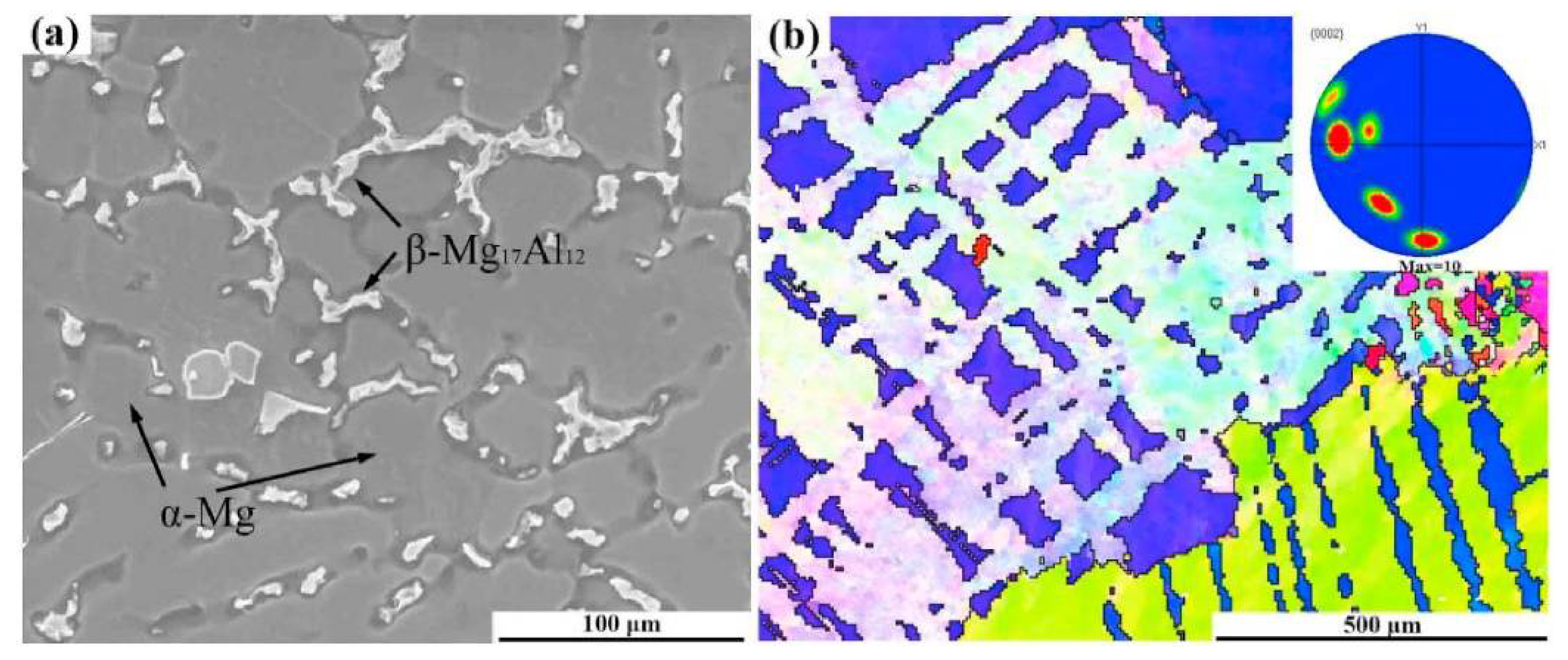
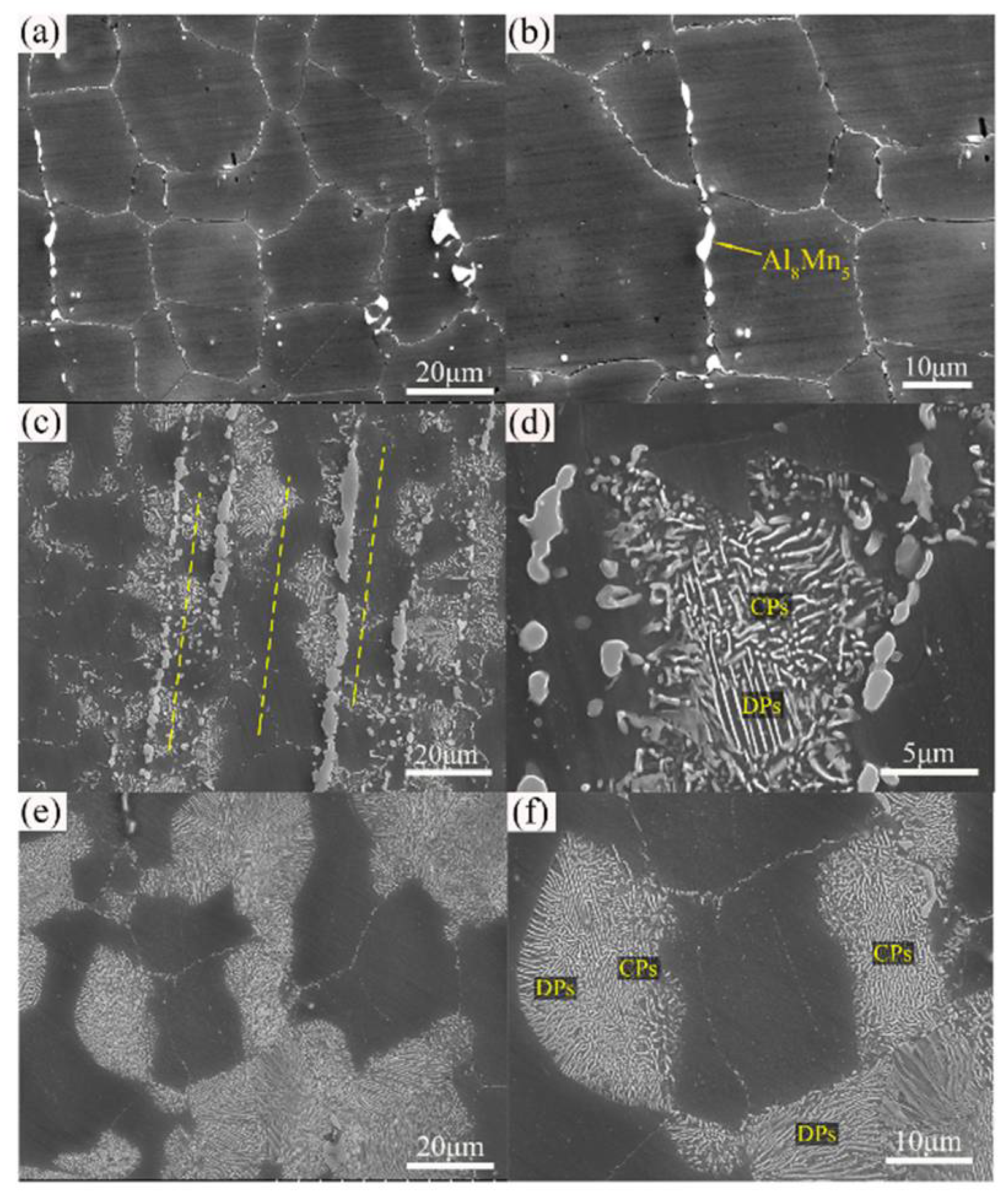
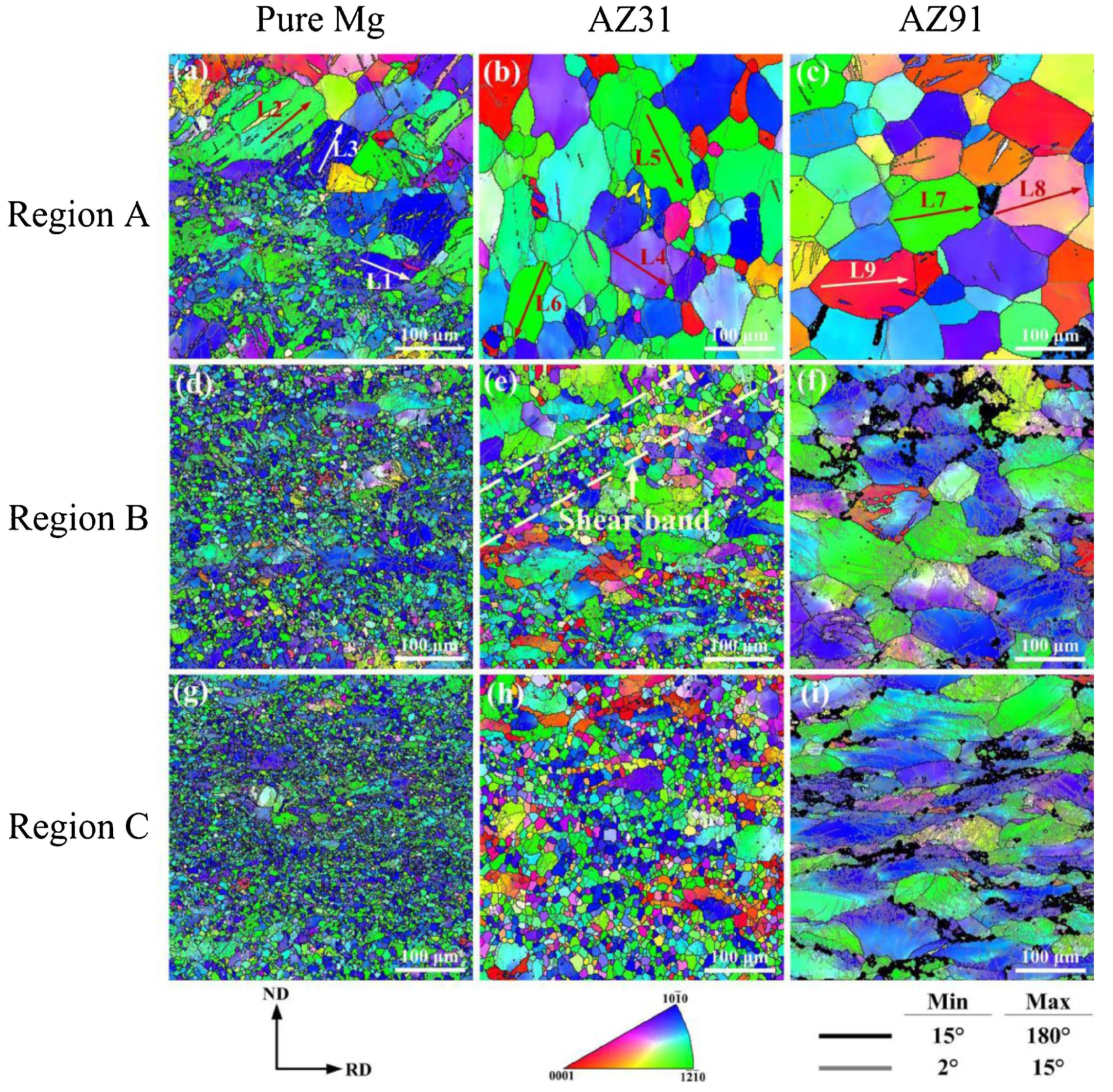
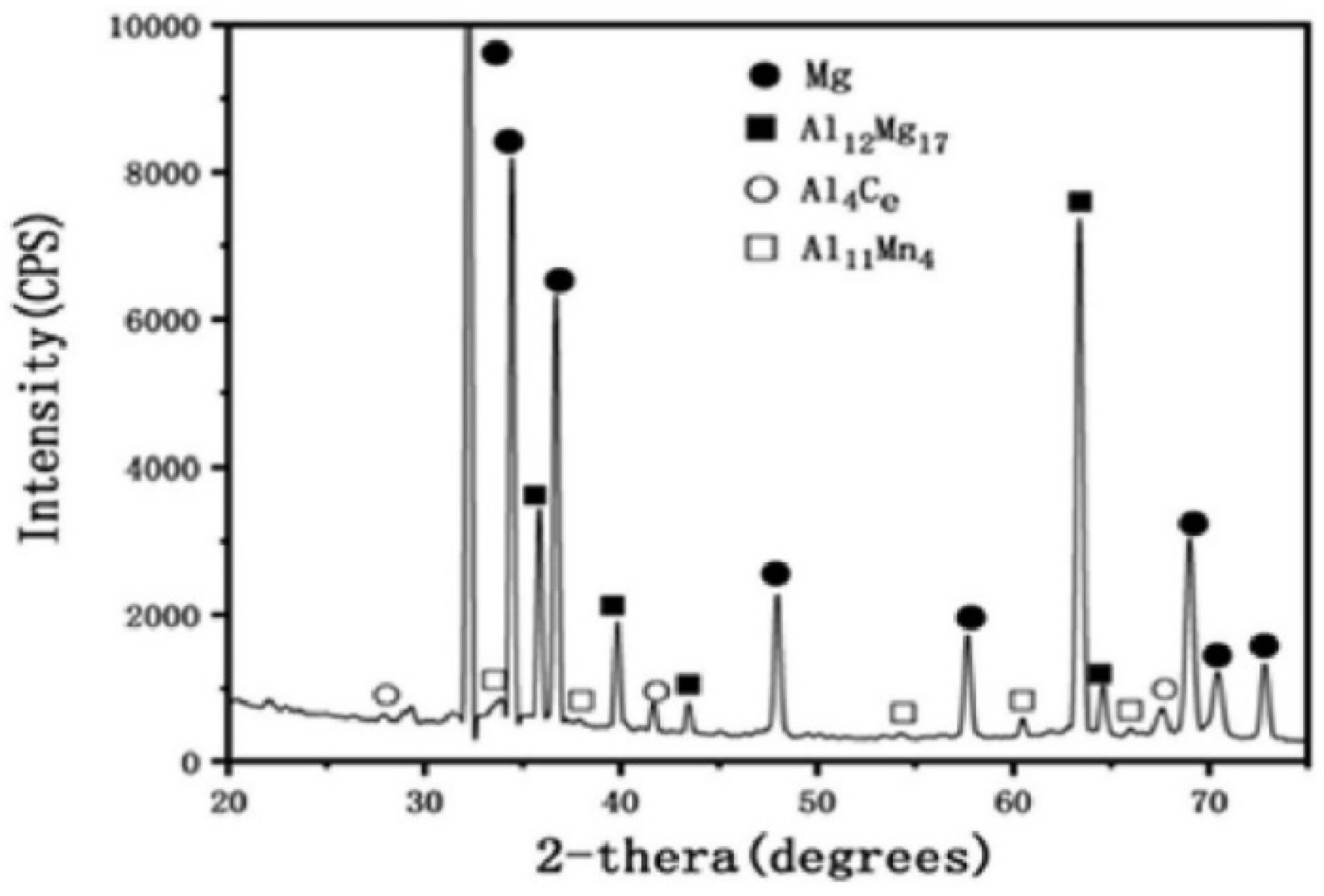
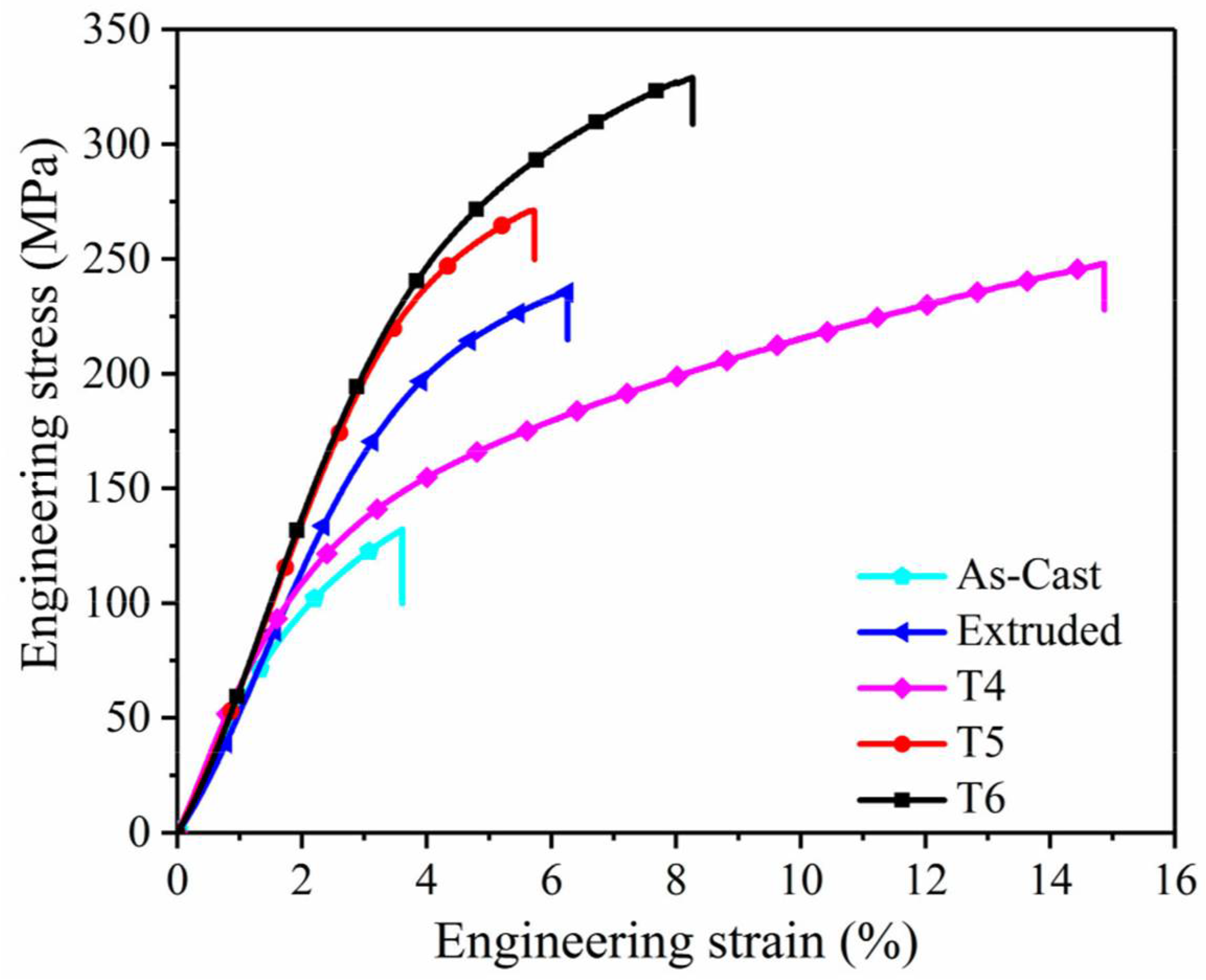

| Materials | Electrolyte | Method | ECorr (V) | ICorr (mA/cm2) | C.R. (mm/Year) | Ref. |
|---|---|---|---|---|---|---|
| AZ80—T4 390 °C 24 h | 3.5% NaCl | Immersion test | - | - | 18.2 | [78] |
| AZ80—T6 250 °C 16 h | - | - | 3 | |||
| AZ80—T6 250 °C 30 h | - | - | 5 | |||
| AZ80—T6 250 °C 48 h | - | - | 3 | |||
| AZ80—T6 330 °C 16 h | - | - | 12 | |||
| AZ80—T6 330 °C 30 h | - | - | 11 | |||
| AZ80—T6 330 °C 48 h | - | - | 9 | |||
| AZ80 | 3.5% NaCl | Immersion test | - | - | 8 | [84] |
| Potentiodynamic | −1.446 | 6.037 × 10−2 | - | |||
| AZ80—T4 420 °C 12 h | Immersion test | - | - | 14 | ||
| Potentiodynamic | −1.424 | 5.574 × 10−2 | - | |||
| AZ80—T6 175 °C 28 h | Immersion test | - | - | 5 | ||
| Potentiodynamic | −1.436 | 5.713 × 10−2 | - | |||
| AZ80 | SBF—pH: 4 | Potentiodynamic | −1.7016 | 8.5627 × 10−2 | - | [87] |
| SBF—pH: 7.4 | −1.5957 | 3.7453 × 10−3 | - | |||
| SBF—pH: 9 | −1.4905 | 6.8479 × 10−4 | - | |||
| AZ31 | 3.5% NaCl | Potentiodynamic | −1.535 | 44.25 | - | [94] |
| AZ61 | −1.529 | 26.74 | - | |||
| AZ91 | −1.489 | 24.02 | - |
Disclaimer/Publisher’s Note: The statements, opinions and data contained in all publications are solely those of the individual author(s) and contributor(s) and not of MDPI and/or the editor(s). MDPI and/or the editor(s) disclaim responsibility for any injury to people or property resulting from any ideas, methods, instructions or products referred to in the content. |
© 2023 by the authors. Licensee MDPI, Basel, Switzerland. This article is an open access article distributed under the terms and conditions of the Creative Commons Attribution (CC BY) license (https://creativecommons.org/licenses/by/4.0/).
Share and Cite
B., S.P.; Dhanaji, T.U.; Dassani, S.; Somasundaram, M.; Muthuchamy, A.; Raja Annamalai, A. Microstructural, Mechanical, and Corrosion Properties of AZXX Magnesium Alloy: A Review of Processing Methods. Crystals 2023, 13, 344. https://doi.org/10.3390/cryst13020344
B. SP, Dhanaji TU, Dassani S, Somasundaram M, Muthuchamy A, Raja Annamalai A. Microstructural, Mechanical, and Corrosion Properties of AZXX Magnesium Alloy: A Review of Processing Methods. Crystals. 2023; 13(2):344. https://doi.org/10.3390/cryst13020344
Chicago/Turabian StyleB., Shalu Pargavi, Todkar Utkarsh Dhanaji, Sejal Dassani, M. Somasundaram, A. Muthuchamy, and A. Raja Annamalai. 2023. "Microstructural, Mechanical, and Corrosion Properties of AZXX Magnesium Alloy: A Review of Processing Methods" Crystals 13, no. 2: 344. https://doi.org/10.3390/cryst13020344





